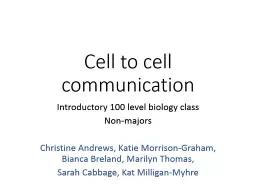

Introductory 100 level biology class Nonmajors Christine Andrews Katie MorrisonGraham Bianca Breland Marilyn Thomas Sarah Cabbage Kat Milligan Myhre Goals Understand how cells communicate and pass on information ID: 558367
Download Presentation The PPT/PDF document "Cell to cell communication" is the property of its rightful owner. Permission is granted to download and print the materials on this web site for personal, non-commercial use only, and to display it on your personal computer provided you do not modify the materials and that you retain all copyright notices contained in the materials. By downloading content from our website, you accept the terms of this agreement.
Slide1
Cell to cell communication
Introductory 100 level biology class
Non-majors
Christine Andrews, Katie Morrison-Graham, Bianca
Breland
, Marilyn Thomas,
Sarah Cabbage, Kat Milligan-
MyhreSlide2
Goals
Understand how cells communicate and pass on information
Appreciate the importance of cell-cell communication to drug activities and response to the environment
Objectives
Describe and diagram a process by which cells communicate
Predict the cause or consequence of alterations in cell communication and justify your answerSlide3
Summative Assessment on an exam
Ask students to draw or identify components of a signaling pathway
We will provide a scenario (s) and ask students to: Identify if an agonist or antagonist is described
Predict effect on cell and/or whole organismSlide4
Class prep work
Multiple questions about readingsSlide5
Scenario
It’s a dark and stormy night… You are walking home alone and you hear a rustle in the bushes. What do you feel? What is happening in your body?Slide6
Fight or Flight ResponseSlide7
Cell communication review
Organize strips in envelope #1 in proper order for cell-cell communication
2 minutesCheck and discuss order of stripsSlide8
Signaling CellSignaling Molecule
Exocytosis of Signaling Molecule
Signal Molecule Travels to Target CellTarget CellBinding to ReceptorG Protein ActivationSecond MessengerResponseSlide9
Cell communication review
Draw the cell signaling pathway described on the strips on your white boards.
3 minutesSlide10
Mini lecture on agonist/antagonistSlide11
Sort shapes into categories of agonists, antagonists, no effect and be prepared to justify your answers (Envelope #2)
4
2
3
5
1
SSlide12
What is the main signaling molecule for fight or flight response?Slide13
What would an
antagonist of epinephrine do to your heart rate? (TPS) Slide14
Can you think of a reason you would like to take an antagonist for this? (TPS)Slide15
Brainstorm: What other examples of cell-cell communication can you think of?
Goal is to reinforce that there are multiple examples of cell – cell communication in the body.Slide16
Goals
Understand how cells communicate and pass on information
Appreciate the importance of cell-cell communication to drug activities and response to the environment
Objectives
Describe and diagram a process by which cells communicate
Predict the cause or consequence of alterations in cell communication and justify your answer